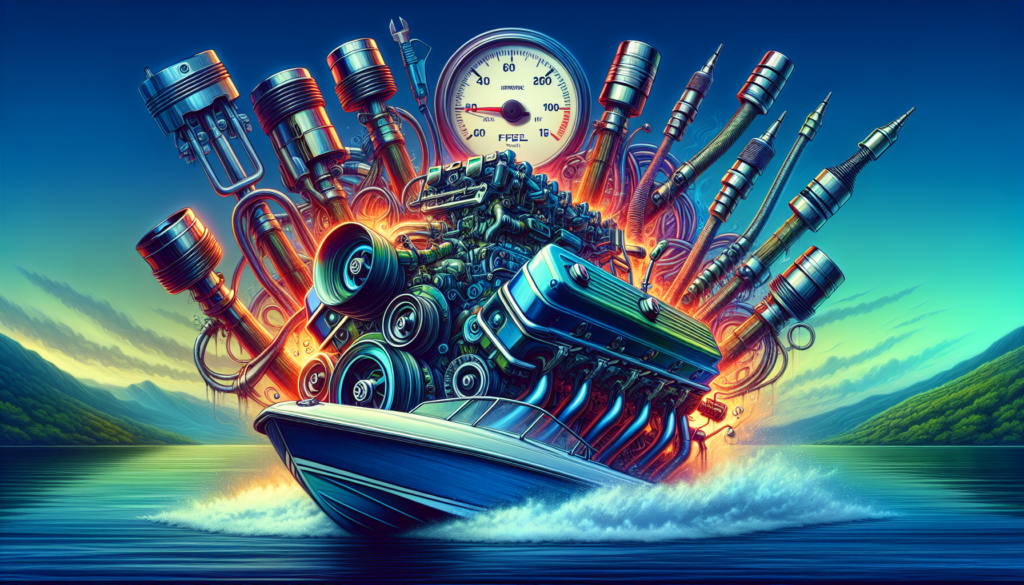If you’re an avid boater or just beginning to navigate the world of boat engines, you may be curious about the most popular modifications enthusiasts make to enhance their horsepower and performance. From simple upgrades to more complex overhauls, this article explores the ever-evolving world of boat engine modifications. Whether you’re seeking better fuel efficiency, increased speed, or improved handling, you’re sure to find inspiration within these pages. So, let’s set sail and discover some of the most sought-after boat engine modifications out there.

1. Fuel System Modifications
1.1 Carburetor Upgrades
When it comes to enhancing the performance of your boat’s engine, upgrading the carburetor is a popular choice. A carburetor upgrade can lead to improved fuel efficiency, increased horsepower, and smoother operation. By replacing the stock carburetor with a high-performance one, you can achieve better fuel atomization and air-to-fuel ratio, resulting in enhanced combustion and power output. Additionally, a new carburetor can provide better throttle response and eliminate common issues such as flooding or hesitation. Upgrading your carburetor is a cost-effective modification that can significantly improve the overall performance of your boat’s engine.
1.2 Fuel Injection Conversion
Another commonly sought-after fuel system modification is converting from a carbureted system to a fuel injection system. Fuel injection offers numerous advantages over a carburetor, including improved fuel efficiency, precise fuel delivery, and better throttle response. By replacing the carburetor with fuel injectors, the engine receives a precisely metered amount of fuel, optimized for the engine’s specific needs at any given time. This results in more efficient combustion, reduced emissions, and increased power output. Additionally, fuel injection systems are equipped with electronic controls that can adapt to changing conditions, ensuring optimal performance at all times.
1.3 Fuel Pump Enhancements
Upgrading the fuel pump is another modification that can make a noticeable difference in your boat’s engine performance. A high-performance fuel pump can provide a constant and reliable fuel supply, even under demanding conditions. With increased fuel flow, the engine can receive an adequate amount of fuel to meet its power requirements. This not only improves performance but also prevents fuel starvation and allows for the use of higher horsepower applications. Moreover, a fuel pump upgrade is often necessary when making other engine modifications, such as adding forced induction or increasing the engine’s displacement.
2. Ignition System Upgrades
2.1 High-Performance Spark Plugs
Upgrading the spark plugs in your boat’s engine is a simple yet effective way to enhance its performance. High-performance spark plugs are designed to provide a more reliable and efficient ignition of the fuel mixture. They can generate a stronger spark, ensuring better combustion and improved power output. These spark plugs are often made with advanced materials and technologies that offer increased durability and resistance to fouling. By installing high-performance spark plugs, you can experience smoother idling, quicker acceleration, and better overall engine performance.
2.2 Ignition Coil Enhancements
The ignition coil plays a crucial role in delivering the high voltage necessary to ignite the air-fuel mixture in the combustion chambers. By upgrading the ignition coil, you can ensure a stronger and more consistent spark, resulting in improved engine performance. Enhanced ignition coils have the ability to generate higher voltage outputs and provide a more reliable and efficient ignition process. This can lead to better fuel combustion, increased power output, and improved fuel efficiency. Upgrading your ignition coil is a relatively simple modification that can greatly enhance the performance of your boat’s engine.
2.3 Electronic Ignition Conversion
Converting from a conventional points-based ignition system to an electronic ignition is a popular upgrade for boat engines. Electronic ignition systems offer several advantages over their traditional counterparts, including improved reliability, increased power output, and better fuel efficiency. Unlike points-based systems that can wear over time, electronic ignitions use solid-state components that are more durable and require less maintenance. This results in more consistent spark timing and better combustion, leading to enhanced performance. Moreover, electronic ignition systems often come with adjustable rev limiters and timing curves, allowing for further customization to suit your specific needs.
2.4 Ignition Timing Advancements
Optimizing the ignition timing of your boat’s engine can have a significant impact on its performance. Advancing the ignition timing can lead to improved combustion efficiency, increased horsepower, and better throttle response. However, it’s important to carefully calibrate the ignition timing and avoid excessive advance to prevent engine damage. Retarding the ignition timing, on the other hand, can help reduce the risk of detonation and overheating in high-performance applications. Adjusting the ignition timing is a modification that should be approached with caution and may require professional expertise to ensure optimal results.
3. Cooling System Enhancements
3.1 Water Pump Upgrades
Maintaining a proper cooling system is crucial for the longevity and performance of your boat’s engine. Upgrading the water pump can greatly improve the cooling efficiency and prevent overheating, especially in high-performance applications. A high-flow water pump can increase the circulation of coolant, allowing for better heat transfer from the engine to the radiator. This helps maintain optimal operating temperatures, even under heavy loads or in hot weather conditions. Upgrading the water pump is a proactive modification that can prevent engine damage caused by excessive heat and ensure consistent performance.
3.2 Radiator Modifications
The radiator plays a vital role in the cooling system by dissipating the heat absorbed by the coolant. Modifying the radiator can enhance its cooling capacity and efficiency, leading to improved engine performance. One common modification is increasing the radiator’s core size, which allows for more coolant flow and greater heat dissipation. This can be particularly beneficial in demanding applications that generate a significant amount of heat, such as towing or racing. Additionally, upgrading to a performance radiator made with high-quality materials can provide better durability and resistance to corrosion, ensuring long-lasting cooling performance.
3.3 Cooling Fan Improvements
The cooling fan is responsible for drawing air through the radiator, facilitating the cooling process. Upgrading the cooling fan can result in improved airflow and better heat dissipation, especially at low speeds or during idle. Electric fans are a popular choice for upgrades, as they offer better control over the cooling process. Unlike mechanical fans, electric fans can be activated on-demand, reducing unnecessary power consumption and improving overall engine performance. Additionally, electric fans can be equipped with adjustable controllers or thermostatic switches, allowing for further customization based on the engine’s cooling requirements.
4. Air Intake Modifications
4.1 Cold Air Intake Systems
Improving the air intake system is a common modification to enhance engine performance. Cold air intake systems are designed to supply cooler and denser air to the engine, resulting in increased power output and improved fuel efficiency. By replacing the stock air intake components, such as the air filter housing and intake ducts, with a cold air intake system, you can ensure a consistent flow of cooler outside air to the engine. Cooler air is denser, providing a greater oxygen concentration for better combustion. This modification can lead to noticeable gains in horsepower and torque, as well as improved throttle response.
4.2 Performance Air Filters
Upgrading the air filter is another way to optimize the air intake system of your boat’s engine. Performance air filters offer better filtration efficiency while allowing for increased airflow. These filters are typically made with high-quality materials that can capture a greater amount of airborne contaminants without impeding airflow. By allowing more air to reach the engine, performance air filters can improve combustion efficiency and contribute to enhanced engine performance. Additionally, performance air filters are often reusable and can be cleaned or serviced, providing cost savings over time.
4.3 Throttle Body Upgrades
The throttle body is responsible for regulating the airflow into the engine. Upgrading the throttle body can lead to improved throttle response, better airflow, and increased power output. Larger bore throttle bodies allow for more air to enter the engine, facilitating better combustion and promoting enhanced performance. Additionally, performance throttle bodies are often designed with smoother internal surfaces, reducing turbulence and optimizing airflow. Upgrading the throttle body is a modification that can complement other air intake enhancements and maximize the overall efficiency of your boat’s engine.

5. Exhaust System Modifications
5.1 High-Flow Exhaust Headers
The exhaust system plays a significant role in the performance of your boat’s engine. high-flow headers, also known as exhaust manifolds, are designed to improve exhaust gas flow and reduce backpressure. By replacing the stock exhaust headers with high-performance ones, you can experience increased horsepower and torque, along with a more aggressive exhaust note. High-flow exhaust headers are typically constructed with larger diameter tubing and smooth bends, minimizing restrictions and allowing for better gas scavenging. This modification can result in improved engine breathing, enhanced performance, and a more satisfying boating experience.
5.2 Performance Exhaust Systems
Upgrading the entire exhaust system can further optimize the performance of your boat’s engine. Performance exhaust systems consist of headers, mid-pipes, and mufflers, all designed to enhance exhaust flow and reduce restrictions. By replacing the stock components with high-performance counterparts, you can achieve better scavenging, increased horsepower, and improved fuel efficiency. Performance exhaust systems are often made with lightweight and high-quality materials, offering better durability and corrosion resistance. Moreover, these systems can provide a more aggressive exhaust note, adding a touch of excitement to your boating adventures.
5.3 Catalytic Converter Removal
Removing the catalytic converter is a modification that is often considered for performance gain purposes. While catalytic converters are crucial for reducing harmful emissions, they can also introduce some restrictions to the exhaust flow. By removing the catalytic converter, you can potentially increase horsepower and improve exhaust flow. However, it is essential to note that removing the catalytic converter is illegal in many areas and may result in fines or penalties. Furthermore, it is crucial to consider the environmental impact and comply with local regulations regarding emissions control. Always consult with a professional and familiarize yourself with the legal implications before considering this modification.
6. Supercharger or Turbocharger Installation
6.1 Supercharger Kit Installation
For those seeking significant power gains, installing a supercharger is an exciting option. A supercharger compresses the incoming air, increasing its density and providing a substantial boost in horsepower. Supercharger kits are available for various boat engines and are designed to provide a bolt-on solution for increased power output. By forcing more air into the engine, a supercharger can improve combustion efficiency and deliver impressive performance gains. It’s important to note that superchargers require careful installation and tuning to ensure proper operation and avoid engine damage. Professional assistance is highly recommended to maximize the potential of this modification.
6.2 Turbocharger Kit Installation
Similar to superchargers, turbochargers are another forced induction option to consider for significant power increases. Turbochargers utilize the engine’s exhaust gases to drive a turbine, which in turn compresses the intake air and delivers a substantial increase in horsepower. Turbocharger kits come in various sizes and configurations to accommodate different engine types. The addition of a turbocharger can dramatically improve the power and torque output of your boat’s engine, providing exhilarating performance on the water. Turbocharger installation requires careful engine modifications, such as reinforcing internals and upgrading the cooling system, to handle the increased stress and heat generated by the turbocharger.

7. Engine Tuning and Performance Chips
7.1 ECU Remapping
Engine Control Unit (ECU) remapping, also known as chip tuning, is a popular modification for boosting engine performance. An ECU remap involves modifying the preset programming of the engine’s computer to optimize various parameters, such as fuel delivery, ignition timing, and turbo boost. By customizing the ECU to suit your specific needs, you can unlock additional power, improve throttle response, and enhance overall engine performance. However, it is essential to seek the assistance of a professional tuner who has experience with your particular engine and understands the intricacies of ECU modifications. Proper ECU remapping can unleash the hidden potential of your boat’s engine while ensuring reliability and longevity.
7.2 Performance Chip Upgrades
Performance chips, also known as power programmers or tuners, offer an alternative to ECU remapping for engine tuning. These devices are designed to modify the engine’s parameters and optimize performance without physically altering the ECU itself. Performance chips typically plug into the OBD-II port or are installed in-line with existing wiring harnesses. They can provide pre-configured or customizable tuning options, allowing you to adjust settings to match your desired performance goals. Performance chips can offer noticeable power gains, improved fuel efficiency, and enhanced driving characteristics. However, it is essential to choose a reputable and reliable brand of performance chip and follow the manufacturer’s instructions for proper installation and usage.
8. Propeller and Gear Ratio Changes
8.1 Propeller Selection and Pitch Adjustment
Choosing the right propeller for your boat is crucial for optimizing performance and fuel efficiency. Different propellers have unique characteristics, such as blade count, blade shape, and pitch. Selecting a propeller that matches your boat’s engine and boating application can result in improved acceleration, top speed, and overall handling. Additionally, adjusting the pitch of the propeller can fine-tune its performance to suit your specific needs. Increasing the pitch can provide better top speed but may sacrifice acceleration, while decreasing the pitch can enhance acceleration at the expense of top speed. It’s important to consult with a propeller specialist or boat manufacturer to determine the ideal propeller and pitch for your boat’s engine and intended usage.
8.2 Gear Ratio Modifications
Modifying the gear ratio of your boat’s propulsion system can have a significant impact on its performance. Changing the gear ratio involves replacing the gears in the lower unit or transmission to achieve different speed and torque characteristics. A higher gear ratio can provide better acceleration and low-end power, ideal for water sports or cruising at lower speeds. Conversely, a lower gear ratio can result in increased top speed but may sacrifice low-end power. Modifying the gear ratio requires careful consideration and expertise, as it involves disassembling and reassembling the lower unit or transmission. Professional assistance is highly recommended for this modification to ensure proper installation and reliable operation of the propulsion system.

9. Cylinder Head and Camshaft Upgrades
9.1 Porting and Polishing of Cylinder Heads
Upgrading the cylinder heads of your boat’s engine can significantly improve its performance by enhancing airflow and combustion efficiency. Porting and polishing the cylinder heads involves removing imperfections and optimizing the shape and size of the intake and exhaust ports. This modification allows for better air and fuel flow into the combustion chambers, resulting in improved power output and throttle response. Additionally, porting and polishing can help with heat dissipation and reduce the risk of detonation. It’s important to note that this modification requires advanced knowledge and expertise, as improper porting or polishing can negatively impact engine performance. Seeking the assistance of a professional engine builder or performance shop is recommended for this modification.
9.2 High-Performance Camshaft Installation
The camshaft is a critical component that controls the opening and closing of the engine’s intake and exhaust valves. By installing a high-performance camshaft, you can optimize valve timing, lift, and duration, resulting in improved engine performance. High-performance camshafts are designed to provide more lift and duration, allowing for increased airflow and better combustion. This can lead to enhanced power output, increased torque, and improved throttle response. However, it’s important to consider the compatibility of the camshaft with other engine components and modifications, as well as the intended usage of the boat. Consulting with a camshaft specialist or engine builder is essential to select the right camshaft profile for your specific engine and boating application.
10. Engine Block Modifications
10.1 Bore and Stroke Improvements
Modifying the bore and stroke of your boat’s engine is a comprehensive modification that can significantly increase its displacement and power output. Bore and stroke improvements involve enlarging the cylinder bore and/or increasing the crankshaft stroke to achieve a larger engine capacity. By increasing the displacement, more air and fuel can be combusted, resulting in increased horsepower and torque. However, this modification is complex and often requires professional engine building expertise. Modifying the bore and stroke necessitates replacing several internal components, such as pistons, connecting rods, and crankshafts, and may involve machining the engine block. Professional assistance is essential to ensure proper measurements, clearances, and compatibility with other engine components.
10.2 Stroker Kits Installation
Stroker kits offer a comprehensive solution for increasing the displacement of your boat’s engine without the need for extensive machine work. Stroker kits include a crankshaft with a longer stroke and related components to accommodate the increased stroke length. By increasing the crankshaft stroke, the engine’s displacement is increased, resulting in improved power output. Stroker kits are specifically designed to ensure compatibility with the engine block and other components, simplifying the installation process. However, it is important to consider the potential impact on the engine’s durability and reliability, as increasing the stroke can introduce additional stress on various internal components. Seeking the guidance of a professional engine builder is recommended for this modification.
In conclusion, there are numerous popular boat engine modifications available to enhance the performance of your boat’s engine. From fuel system upgrades to engine block modifications, each modification can provide noticeable improvements in horsepower, torque, fuel efficiency, and overall engine performance. However, it’s essential to approach these modifications with caution and consider the compatibility with other components and the intended usage of the boat. Seeking professional advice and expertise is highly recommended to ensure the best results and maximize the potential of your boat’s engine. With the right modifications, you can take your boating experience to new heights and enjoy the thrill of a high-performance marine engine.


